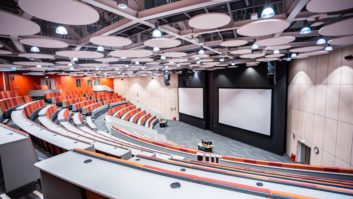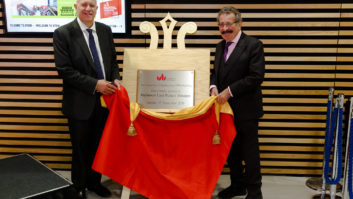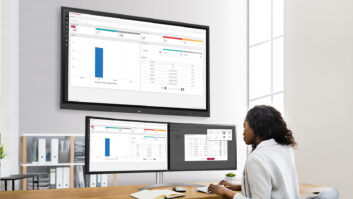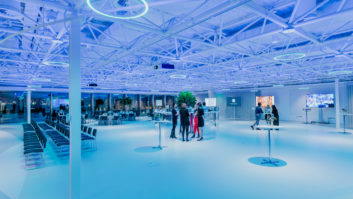It’s probably safe to say that the pandemic has forced the accelerated adoption of remote solutions for businesses in most sectors, and for many the changes made to their day-to-day operations will become permanent with ‘hybrid’ in-person/remote environments set to become part of a ‘new normal’. But what does this new reality look like for education facilities and how important a role will AV solutions play in enabling flexible learning into the future?
 To find out, we assembled a cast of experts from the supply chain to offer their perspectives. Joining the debate are Christian Bozeat, director, Macom GmbH UK; Toni Moss, owner and MD at CDEC; Prof Trevor Keeble, executive dean of creative and cultural industries at the University of Portsmouth; Andrew Taylor, project manager, Kinly; Adam Harvey CTS, solution architect, AV and digital media, University of Hertfordshire; Alistair Meachin and Ross McLee, Harmonia Consulting; John Hulen, national education director at Crestron; and Colin Etchells, group technical director, Saville Group.
To find out, we assembled a cast of experts from the supply chain to offer their perspectives. Joining the debate are Christian Bozeat, director, Macom GmbH UK; Toni Moss, owner and MD at CDEC; Prof Trevor Keeble, executive dean of creative and cultural industries at the University of Portsmouth; Andrew Taylor, project manager, Kinly; Adam Harvey CTS, solution architect, AV and digital media, University of Hertfordshire; Alistair Meachin and Ross McLee, Harmonia Consulting; John Hulen, national education director at Crestron; and Colin Etchells, group technical director, Saville Group.
What would you say is the biggest effect of the pandemic on the ed-tech sector? It has obviously accelerated the adoption of distance learning solutions in the short term, but will it trigger longer term effects such as a more deliberate shift to hybrid physical/remote learning environments?
 Christian Bozeat (CB): The biggest effect we have seen is the realisation that, in education, they have to take things seriously with regards to AV and VC, and how technology to support education has to be assessed and proper proof of concepts deployed in order to test the findings and any revised working processes before being fully rolled out. It has obviously accelerated the adoption of distance learning solutions in the short term, but will it trigger longer term effects such as a more deliberate shift to hybrid physical/remote learning environments? With costs of education and accommodation climbing ever higher and higher there will definitely be a shift to more distance learning and an increase in hybrid learning facilities. In order to enable this there will need to be changes in lots of areas of academic life and teaching processes. These will need to be supported by AV (not just as a section of IT) to support video editing, broadcast and filming, streaming as well as video archiving and storage management. The AV support team will be come more important as lectures become broadcast live events.
Christian Bozeat (CB): The biggest effect we have seen is the realisation that, in education, they have to take things seriously with regards to AV and VC, and how technology to support education has to be assessed and proper proof of concepts deployed in order to test the findings and any revised working processes before being fully rolled out. It has obviously accelerated the adoption of distance learning solutions in the short term, but will it trigger longer term effects such as a more deliberate shift to hybrid physical/remote learning environments? With costs of education and accommodation climbing ever higher and higher there will definitely be a shift to more distance learning and an increase in hybrid learning facilities. In order to enable this there will need to be changes in lots of areas of academic life and teaching processes. These will need to be supported by AV (not just as a section of IT) to support video editing, broadcast and filming, streaming as well as video archiving and storage management. The AV support team will be come more important as lectures become broadcast live events.
 Toni Moss (TM): The biggest effect, undoubtedly, was the rapid shift to distance learning, and later in the year greater investment in hybrid learning environments. At a higher education level in particular, the realisation that in-person learning would be extremely limited even into 2021 came quite early in the progress of the pandemic, so we’ve seen many institutions invest in Zoom Rooms and other distance learning-equipped spaces. What’s interesting is that these spaces are being designed with flexibility in mind, and they’re being utilised in a variety of ways even now, so in the longer term we expect to see the continued use of these hybrid spaces for a number of tasks. This might include seminar-style group work, to bring in a wider range of guest speakers without them needing to be in the room, or for tutors to teach out from to students who can be much more geographically dispersed than in the past – something that could provide a much-needed revenue stream for universities.
Toni Moss (TM): The biggest effect, undoubtedly, was the rapid shift to distance learning, and later in the year greater investment in hybrid learning environments. At a higher education level in particular, the realisation that in-person learning would be extremely limited even into 2021 came quite early in the progress of the pandemic, so we’ve seen many institutions invest in Zoom Rooms and other distance learning-equipped spaces. What’s interesting is that these spaces are being designed with flexibility in mind, and they’re being utilised in a variety of ways even now, so in the longer term we expect to see the continued use of these hybrid spaces for a number of tasks. This might include seminar-style group work, to bring in a wider range of guest speakers without them needing to be in the room, or for tutors to teach out from to students who can be much more geographically dispersed than in the past – something that could provide a much-needed revenue stream for universities.
In addition, whereas reluctance or uncertainty around utilising distance learning tools and other technology may have been an issue in the past among some teachers, being forced to use them has led to the realisation among many that they do work, they can be relied upon and they do have a place in the world of learning. In many ways the pandemic has given these tools the opportunity to prove themselves and that could have a significant impact on their uptake going forward.

Prof Trevor Keeble (TK): The pandemic has helped people to realise alternate ways of teaching and learning, and has given academic communities confidence that digital technologies and systems are robust enough to enable different ways of doing their work. We probably need to be cautious, however, in how closely we understand this to be distance learning which as a specialist mode of provision, designed as the name suggests to be done at a distance, is often undertaken autonomously. This is certainly not what most UK HEIs undertook at speed during the first lockdown. The digital shift in teaching enforced by the pandemic was still incredibly intensive for both students and staff and included a lot of synchronous face-to-face teaching and cohort engagement.
Most universities, my own included, pride themselves on the importance of campus and the learning environment so to do without it or to have it restricted as more recently is fundamentally a pedagogic challenge. Social distancing measures have meant that digital delivery has continued significantly throughout the current academic year but this has, where possible, taken a blended approach and been situated within the campus and learning environment, much of which is absolutely crucial for different types of applied learning. That said, the digital shift has pushed academics to investigate more fully the different possibilities of technology as appropriate to different kinds of learning. At the University of Portsmouth, a number of my colleagues have relinquished some dearly held lab-based learning-by-rote in favour of real-time community-led online learning environments and discussion platforms such as Discord. This has enabled a different kind of learning and engagement that has empowered students, and is clearly something we will be sticking with.
 Andrew Taylor (AT): The adoption of distance learning was gaining pace long before the pandemic, this has only served to force users who had been hesitant to adopt these technologies to engage with them. The long term continued success/adoption of these technologies will only continue if institutions can build on this, by using adoptions programs/services, while looking for technology synergies for example, users have previously been used to using MS Teams as a communications platform, and can now leverage the MS Teams Rooms Systems to turn their classrooms into hybrid environments where those who may need to shield or can’t travel and take part in a lesson with their onsite piers. Barco’s weConnect system has been the flagship for this hybrid classroom setup for some time. The ability to integrate these solutions with VLE’s also needs to be maximised so that the technology teams and the learning technology teams can offer a streamlined and effective service.
Andrew Taylor (AT): The adoption of distance learning was gaining pace long before the pandemic, this has only served to force users who had been hesitant to adopt these technologies to engage with them. The long term continued success/adoption of these technologies will only continue if institutions can build on this, by using adoptions programs/services, while looking for technology synergies for example, users have previously been used to using MS Teams as a communications platform, and can now leverage the MS Teams Rooms Systems to turn their classrooms into hybrid environments where those who may need to shield or can’t travel and take part in a lesson with their onsite piers. Barco’s weConnect system has been the flagship for this hybrid classroom setup for some time. The ability to integrate these solutions with VLE’s also needs to be maximised so that the technology teams and the learning technology teams can offer a streamlined and effective service.
 Adam Harvey (AH): In my opinion, what this has given us going forward is the ability to deliver a blend of teaching. Our teaching had to rapidly move online due to necessity; some of it works well and will no doubt continue but some disciplines need to use campus-based facilities to enable the teaching to be the best it can be. The forced online adoption has given academic staff the ability to try new things but balanced against the fact that it was a hard and fast learning curve. We do seem to be getting more ‘Why can’t I do this with product x?’ over the ‘How do I use product x?’. Support staff have been busy helping staff adapt content for online and we can now look at the technology we have and whether it is fit for purpose for all. What you do lose by teachers not attending on campus is the ‘University life’ which is a very important part of the journey.
Adam Harvey (AH): In my opinion, what this has given us going forward is the ability to deliver a blend of teaching. Our teaching had to rapidly move online due to necessity; some of it works well and will no doubt continue but some disciplines need to use campus-based facilities to enable the teaching to be the best it can be. The forced online adoption has given academic staff the ability to try new things but balanced against the fact that it was a hard and fast learning curve. We do seem to be getting more ‘Why can’t I do this with product x?’ over the ‘How do I use product x?’. Support staff have been busy helping staff adapt content for online and we can now look at the technology we have and whether it is fit for purpose for all. What you do lose by teachers not attending on campus is the ‘University life’ which is a very important part of the journey.
 Alistair Meachin/Ross McLee (AM/RM): Teaching institutions have been forced to acknowledge that they are not always in a position to deliver high quality teaching to remote audiences especially at short notice. Those most affected were the primary and secondary schools who provide face-to-face teaching for the majority of their lessons. As the pandemic forced us into a lockdown state, the likes of the universities who already have invested heavily in virtual learning environments were able to pick up the reins and fill the gaps relatively easily. Whereas younger students were only able to download worksheets and watch YouTube videos with sporadic interaction with their class teachers.
Alistair Meachin/Ross McLee (AM/RM): Teaching institutions have been forced to acknowledge that they are not always in a position to deliver high quality teaching to remote audiences especially at short notice. Those most affected were the primary and secondary schools who provide face-to-face teaching for the majority of their lessons. As the pandemic forced us into a lockdown state, the likes of the universities who already have invested heavily in virtual learning environments were able to pick up the reins and fill the gaps relatively easily. Whereas younger students were only able to download worksheets and watch YouTube videos with sporadic interaction with their class teachers.
The lockdown has meant most educators have stayed at home, and there was little need for them to go back to the classroom and deliver their lessons from there. It is likely we will continue to see a greater demand for IT-based solutions for virtual classrooms at home, with the AV elements provided through consumer products that your average YouTuber might use. Improved audio (be it a headset or studio microphone) along with improved lighting and acoustics will possibly become the norm. Educators may set up a space in their homes as a dedicated studio space. With the advent of virtual backgrounds, with or without a green screen, teachers may even take a photo of their classroom and set it as their background.
 Virtual classrooms are all very well but does it lead to the best teaching experience, where students learn effectively? Probably not. The social interaction and visual cues students and educators get from being in the same room together is a far cry from clicking a mouse on a button to raise your hand and ask a question. Certainly for younger students the whole online meeting experience with the likes of Zoom or Microsoft Teams has been overwhelming, to the point where many are either disengaged or no longer attend. They are unnatural and create a distraction from what you are trying to achieve, and that is teach.
Virtual classrooms are all very well but does it lead to the best teaching experience, where students learn effectively? Probably not. The social interaction and visual cues students and educators get from being in the same room together is a far cry from clicking a mouse on a button to raise your hand and ask a question. Certainly for younger students the whole online meeting experience with the likes of Zoom or Microsoft Teams has been overwhelming, to the point where many are either disengaged or no longer attend. They are unnatural and create a distraction from what you are trying to achieve, and that is teach.
Practical activities: PE, art, lab experiments and technical skills cannot be solely taught online. So a balance has to be struck between virtual and reality. These activities may very well be recorded and distributed to learn how to do them, but you still need students to practice them so hybrid environments do lend themselves well in this respect.
We may see a more obvious division between subjects that can be taught well remotely, and those that need real interaction. If school attendance is limited, this time may be focussed on the latter. ‘Hybridised’ classrooms will continue to be developed and deployed both to aid current distancing requirements and provide future resilience.
 John Hulen (JH): The pandemic has exposed how institutions which rely solely on in-person learning and their brick and mortar campuses will struggle in the new era of online education and remote learning. Today’s students value the virtual experience. They move easily between interacting physically and virtually. Student engagement and teaching material should be viewed in the context of being equitable whether students are physically in the room or joining remotely. Crestron is offering mobile UC cart solutions and installed UC systems to accommodate groups meeting regardless if some members are in-person and others are located elsewhere.
John Hulen (JH): The pandemic has exposed how institutions which rely solely on in-person learning and their brick and mortar campuses will struggle in the new era of online education and remote learning. Today’s students value the virtual experience. They move easily between interacting physically and virtually. Student engagement and teaching material should be viewed in the context of being equitable whether students are physically in the room or joining remotely. Crestron is offering mobile UC cart solutions and installed UC systems to accommodate groups meeting regardless if some members are in-person and others are located elsewhere.
 Colin Etchells (CE): Many higher education (HE) establishments already had distance learning solutions in place, with managed and virtual learning environments (MLEs and VLEs) in common use for delivering content perhaps to a smaller population of a university’s students. Suddenly and with limited notice, lecture and lessons plans needed to be rethought, rewritten and delivered in a completely different way. Distance learning, just as video calling from home, suddenly became mainstream. Videoconferencing, video streaming and content management platforms such as Blackboard, Moodle, etc became business critical like never before. The ability for many HE institutions to cope at short notice has, without doubt shown that a hybrid learning model is here to stay. The benefits have already been demonstrated and as we enter a post-lockdown era, many educational facilities are starting to roll out their ‘new normal’ learning experiences that combine the best of online and in-person study.
Colin Etchells (CE): Many higher education (HE) establishments already had distance learning solutions in place, with managed and virtual learning environments (MLEs and VLEs) in common use for delivering content perhaps to a smaller population of a university’s students. Suddenly and with limited notice, lecture and lessons plans needed to be rethought, rewritten and delivered in a completely different way. Distance learning, just as video calling from home, suddenly became mainstream. Videoconferencing, video streaming and content management platforms such as Blackboard, Moodle, etc became business critical like never before. The ability for many HE institutions to cope at short notice has, without doubt shown that a hybrid learning model is here to stay. The benefits have already been demonstrated and as we enter a post-lockdown era, many educational facilities are starting to roll out their ‘new normal’ learning experiences that combine the best of online and in-person study.
“AV is the king, enabling technology for one-to-one or one-to-many information transfer and the pandemic has aided its rapid adoption by everybody” Colin Etchells
From your perspective, do you think that the full value of AV solutions is becoming better understood by the education community, or is there an ongoing education process (no pun intended) that needs to take place?
CB: Unfortunately it is still the case that the education sector has a lot to learn in respects to technology deployments: many still think in terms of hardware rather than understanding the education process and working on solutions that support it, or that enable greater productivity and information retention. Unfortunately, as with all other industries, the thought process behind the selection the right tools for a project is lacking. Institutions need to put more effort in to research and process development in order to improve. One thing that never ceases to amaze me is the lack of willingness for change within the education sector. Educators don’t want to take the time to change their working processes in order to incorporate new technology – it is often seen as a pain rather than something that should be embraced. How many universities have a change management process in place to help lecturers utilise the full benefits of technology? You would think this was a given for those educating others!
TM: I certainly think educators have come to value some AV solutions more, as without them they simply wouldn’t have been able to teach effectively during lockdown. Those tools that have proved themselves reliable, useful and intuitive will likely be adopted more even as institutions move back to some kind of normality. Similarly, those tools that haven’t delivered won’t be.
Many teachers have wanted to do more than talk at students over video or set individual tasks and this has been made possible with AV. Having said that, there is still more to be done in terms of ensuring teachers know the full capabilities of the solutions available to them, and this education process needs to be ongoing as products develop and software is upgraded.
TK: One of the great challenges of EdTech, or indeed any AV solution, is that too often it is understood as a technological opportunity that might be applied to a pedagogic challenge or problem. Whilst this was certainly an imperative of the sudden move to online teaching and engagement in the first lockdown, this was to some extent trial and error at speed; colleagues working out which technologies, or indeed specific functions of technologies, worked better than others in the moment. Not surprisingly, the picture for most technologies was one of upsides and downsides. For academics, technology is invariably a means to an end and the adoption of new technologies and systems will be far swifter if the innovations of those technologies are pedagogically-led.
What we need now, is less an education and more a collaborative learning, as the great opportunity for the hopefully soon-to-be post-lockdown moment is that educationalists, students and technologists have the chance now to work together to better understand the impact of what has taken place and what can be successfully carried forward and developed in the future.
AT: Unfortunately there are some deep divisions still existing, particularly in higher education where school, faculties and departments are too compartmentalised in their thinking. Fortunately there are some great examples of people taking a combined and well thought out approach to education technology and its integration into teaching. The Catalyst project at a well known university in the West Midlands is a bit of a beacon at the moment. Currently in the build phase, this development will deliver flexible teaching spaces where users can make the best use of onsite delivery as well as online participation. Projects like this are being lead by strong experienced technologists who see the value in working across teams and disciplines. Another example of this forward thinking approach would be the University of Northampton’s award winning Waterside Campus. The work of collaboration technology experts within these universities really need to be championed. A great way of fostering this would be education forums such as the LTSMG, which has a great mix of audio visual, IT and learning technology experience. Where members can swap ideas and engage with interested suppliers to develop these ideas.
AM/RM: There has been a significant acceptance of remote working and now remote learning across all areas in the education sector. Students are ever more capable of accessing content online, live and recorded. The expectation is that content (educational or otherwise) should be accessible online 24/7.
Expectations are raised even further when the quality of material is of a high standard. YouTubers who have poor quality videos are often ignored and channels with the better production standards are followed in their millions. To keep students engaged remotely requires the content to be engaging and interactive. A deck of PowerPoint slides, a voice over and a worksheet just won’t cut it.
Educators are realising this and their ability to produce high quality and engaging material is now under scrutiny. The quality of the AV systems needs to support this.
Rapid deployment of simple solutions has filled a gap, but may not be strategically aligned to long term plans. The ‘just get it done’ approach we have seen to accommodate the pandemic conditions needs to be readdressed and a strategy needs to be developed on how to produce such content.
While students and parents are very much appreciative of the efforts our teachers have gone to to continue to deliver ‘something’ during lockdown, there are educators out there who are reluctant to record their teaching material in fear that it will simply be copied and distributed, devaluing them as mere talking heads on-screen. Indeed, there are instances where microphones have been deliberately removed from classrooms to ensure a recording cannot take place. This is a mindset that is not without justification; institutions need to reassure their teaching staff that their intellectual input and their ability to engage with students is still highly valued.
CE: Having worked in the HE sector in a number of roles, I can in all honesty say that the value of AV within the education sector has always been well understood and over recent years the innovation and adoption of state-of-the-art technologies has become more prevalent. There are huge benefits to be gained by both lecturers and students when technology is embraced correctly so that it empowers both. As the sector has become more competitive and commercialised, the focus on leading by technology has become more intense. Many institutions have AV systems that align with many high-end corporates. This in itself is a positive as businesses look to enhance and improve their AV systems so that the full potential of postgraduate students can be realised in the working world.
JH: The education community is beginning to understand how impactful AV technology groups are, and do collaborate with them to some extent. However, we envision a time when the faculty and administrators aren’t just asking for input, but instead depend on the AV groups to help them deliver the necessary learning objectives. Schools which have prioritised the use of technology are requiring faculty members to learn how to use the tools and are investing in the training/support which will help those instructors be successful. And as they are learning about how technology can help them, teachers will be able to improve and adjust course material for more effective results.
AH: Luckily my institution has long appreciated the role AV plays in delivering gold standard teaching and we have had great investment over the years. A lot of the conversations I have now are about how we deliver a range of products and services via the AV to support a diverse teaching programme that is simple to use. Using technology to collaborate in-room and remotely and helping everyone engage is a key part of the standard design now. We have a good real estate of great quality AV solutions so that does help teachers think about how they use it to support their teaching and we have a team of people to assist with that.
“The pandemic has exposed how institutions which rely solely on in-person learning and their brick and mortar campuses will struggle in the new era of online education and remote learning” John Hulen
How important a role does AV play in the future of education, both on and off-campus? How much of an enabler can/should/will it be?
CB: It is the future of education, and the sooner it is recognised as such the better it will be and the more resource will be available for its proper deployment. Education suffers from the same issues that all others suffer – they think they can do it themselves, they don’t have the correct people and skills in place, and are lacking the basic processes to design, tender, deploy and support!
TM: It can and should play a huge role. In the classroom, whether virtual or physical, it enables pretty much all the interactions that take place – whether collaborating in small groups at touchscreens, sharing content with wireless presentation systems or projectors, and even ensuring everyone can hear and participate with robust audio setups, AV is crucial. But its value moves far beyond the classroom, and again the Covid pandemic has made its role elsewhere even more important. Think digital signage systems that guide, remind and inform students about the latest rules, one-way systems or room capacity; wayfinding solutions that provide safe routes to navigate campuses; visitor management systems that reduce the need for contact at receptions; and room booking systems that will stop students and teachers entering incorrect or already booked rooms. All of these solutions now have even greater value given the current circumstances and can all help to enable not just an improved learning experience, but also a smoother and safer environment for students and teachers.
The future of education is also likely to see higher education institutions reach out to more potential students, whether that’s offering online-only courses to overseas students, or hybrid evening classes to part-time learners. Finding new ways to boost revenue will be a key task for many in the years to come, and technology will be at the forefront of opportunities here.
TK: Perhaps the most significant impact of the digital shift has been the realisation of a more student-centred learning environment. Certainly in the Faculty of Creative and Cultural Industries at the University of Portsmouth, we have seen a deepening engagement with learning from a range of students for whom engagement has at points been challenging. Whilst we have yet to fully comprehend and reflect upon the huge amount of academic, technical and professional support time it has taken to create a learning experience that has, at many points, needed to be all things to all students, irrespective of location or time-zone, it is clear that our approaches have changed and we are already revising our plans for what we thought we would be doing online and on campus. One of the most obvious changes that could have significant impacts for the entire community of the University is what ‘work’ rather than study will look like and where it will take place in the future University. Lockdown revealed the possibility to constitute and operate the University very differently, and for any institution looking to do that, AV and digital technology will essential.
AT: It’s a pretty important part of the whole experience. It plays a key role in enabling the learning process in pretty much any setting, whether it be displaying content to allowing students and tutors to collaborate and communicate effectively and consistently. A reliable AV environment breeds trust in technology and drives tutors and users to adopt its use. The bells and whistles of it all are important and will attract people to technology; its reliability that’s important. To have very effective educational delivery the tech must be highly available and simple to use. It should be like a good referee in sports: you know he’s there, but you don’t have much to say about him at the end.
CE: AV will always play a pivotal role in the transfer of information/knowledge from one person to another. Whether that’s a lecturer presenting in front of a lecture theatre full of students using extensive AV facilities or using VC and associated peripherals to deliver a remote tutorial to a student sat at home. AV is the king, enabling technology for one-to-one or one-to-many information transfer and the pandemic has aided its rapid adoption by everybody. That said, there is typically no single one-size-fits-all solution and different facilities will need to discover what works for them and their particular circumstances. Students still need to access and learn from a collaborative, group focussed style. The change is that for many, that has now moved from the lecture theatre to a multi-party online experience. Without streaming AV solutions and the traditional, premise-based infrastructure that supports them, the modern learning experience cannot function. AV is pivotal to the success of HE into the future.
JH: Our vision is that AV technology plays a vital role in enabling learning, increasing student engagement, and empowering instructors to use every effective method. Automated systems can work with scheduling software to start/end classes, get voice commands to change volume levels or video sources, provide remote access for support teams, as well as allow for analytics and metrics to better manage and monitor systems all around campuses. In addition, as augmented/virtual reality, artificial intelligence, and other smart sensors or devices are integrated into teaching spaces, Crestron will continue to provide AV groups with the resources to enable any type of learning experience which is desired.
AH: It’s extremely important as a tool to deliver. Using the right tool for the job is always the key. Also important is not to make complex systems complicated to use. The user experience is the major factor in design right now. We have a role to ensure that all academic staff, and professional staff for that matter, have what they need to do their job and there is no massive ‘joining tax’ to using it. The pandemic and switch to working from home has pushed a lot of people onto the likes of [Microsoft] Teams very quickly so we now need to make sure everyone knows how to use the technology to the best advantage.
AM/RM: AV will continue to play an important part of teaching. Students are able to absorb more information through watching multimedia content. Anyone with children who watch the likes of Horrible Histories will know their kids love the gory details of the past and are able to retain far more information than if they had read it from a book or photocopied worksheet. Being able to show this sort of content in-lesson and have access to it at home is ideal. But is that what AV in a classroom means?
‘A screen on a wall’ does not replace the teacher. Their skill-set goes far beyond a few clicks on a computer and getting the kids to watch TV all day. Sometimes the technology is a distraction from the other skills children need to develop: social interaction, questioning, arguing a case, physical activity, art, sport, creative writing and expression… the list is endless. That is where a real teacher is able to develop our children’s knowledge and skills. Indeed those parents who needed to home-school their children during lockdown will realise that maintaining a child’s attention for six hours a day takes more than tables and chairs and a dry wipe board!
I think it is likely that online learning content (like BBC Bitesize or Open University) will become more prevalent in the classroom. With other online content creators producing more material to be played out, good quality AV systems will continue to be needed in every classroom.
The bottom line is that forced rapid technology adoption has driven a leap in acceptance that will push up production standards and expectations, but has also made very clear where AV is no substitute for real life interaction.







